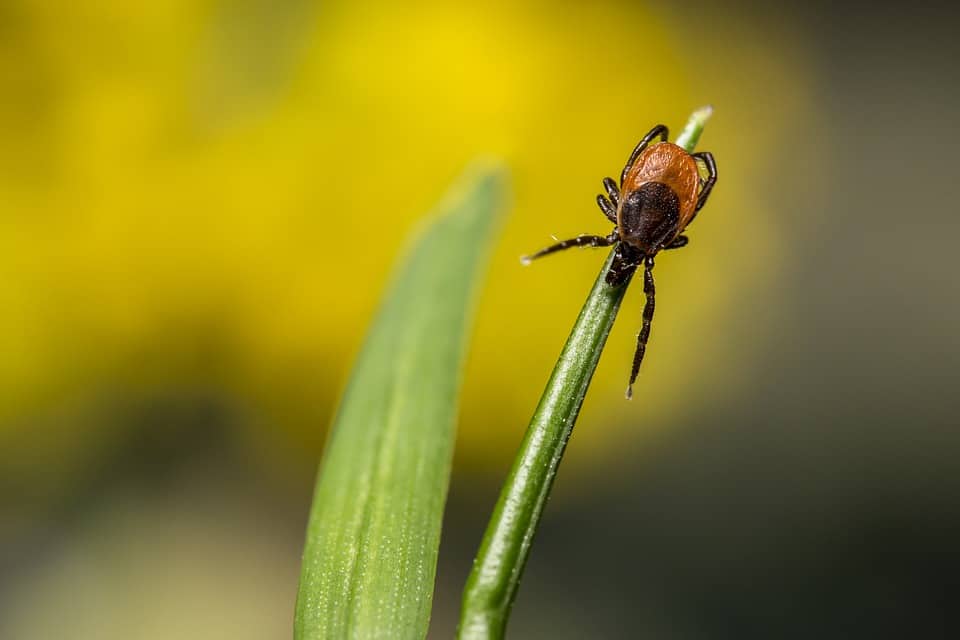Hiking is one of the best ways to enjoy the outdoors. But, spending time outside can expose you to tick bites and the diseases that come with them.
You can prevent tick bites by wearing long pants and by treating your clothing with permethrin. Additionally, wearing bug spray can help you repel ticks outdoors. Then, at the end of a hiking day, completing a thorough tick check can help you find and remove any ticks that may have traveled home with you.
To help keep you safe when you’re camping and hiking, here’s your guide to all things tick-related. Up next, we’ll give you the latest information on tick prevention and walk you through what to do if you get bitten.
What Are Ticks?
A tick is actually a type of arachnid that’s usually between 3 and 5mm long. Ticks are considered “external parasites,” which means they feed off of the blood of mammals, birds, reptiles, amphibians, and reptiles.
There are nearly 1,000 known species of ticks, which live on every continent, except for Antarctica. However, they are most prevalent in warm, humid areas because cold temperatures prevent tick larvae from hatching from their eggs.
What Happens If You Get Bitten By A Tick?
Ticks are what’s known as a “vector,” which means they are a living organism that transmits diseases from one host to another through bites. In fact, tick-borne diseases infect tens of thousands of people in the United States alone.
There are dozens of different diseases that you can get from tick bites, including:
- Lyme Disease
- Rocky Mountain Spotted Fever
- Southern Tick-Associated Rash Illness (STARI)
- Tularemia
- Ehrlichiosis
- Anaplasmosis
- Babesiosis
Most of these illnesses can cause long-term disability or even death. Lyme disease is perhaps the biggest concern for hikers, particularly in the eastern United States and the United Kingdom, however, it’s found in over 80 countries around the world.
How Do You Prevent Tick Bites While Hiking?
Since tick bites can cause some nasty illnesses, avoiding ticks in the first place is of the utmost importance. Two things you can do to prevent tick bites include dressing appropriately and using bug repellent.
What To Wear To Avoid Tick Bites
The experts from Cornell University recommend that people do the following while hiking or camping to avoid ticks:
- Wear light-colored clothing, which makes it easier to spot ticks
- Tuck your pant legs into your socks and wear a sturdy pair of boots
- Opt for pants with elastic waistbands as these make it harder for ticks to sneak in
Also, once you get home, wash your clothing and then tumble dry it on high heat for about 20 minutes. This helps to kill off any ticks that might be hanging around on your clothing and prevents them from biting you later.
Best Way To Repel Ticks
In addition to wearing the correct clothing, there are a few different products that you can use to repel ticks as you hike:
Permethrin
Permethrin is an EPA-approved pesticide that’s been used by the US Military for over 20 years to protect soldiers from insect-borne diseases. It is the only approved pesticide that’s designed to be sprayed onto clothing to protect you from ticks and mosquitos.
You can buy pre-treated permethrin clothing from various retailers, including a pair of gaiters from Outdoor Research. Or, you can treat your own clothing with permethrin spray. Just keep in mind that liquid permethrin is harmful to cats, so keep your kittens away from the spray bottle and any treated clothing until it’s completely dry.
Deet
DEET is a chemical found in many different bug repellents, particularly for mosquitos and ticks. However, DEET does not kill ticks, it just repels them. Although you can buy 100% DEET products, 30% DEET bug spray is the most effective against ticks.
However, DEET can be harmful when swallowed, so it should be used carefully and never on young children.
How To Perform A Tick Check
Performing a tick check is one of the most important things you can do to protect yourself from some nasty diseases. Here’s what you need to do:
- Remove all your clothing. This is easier to do if you’re back in your bathroom at the end of a day hiking trip. But, it still needs to be done if you’re out on a longer backpacking trip. If you’ll be outside for multiple nights in a row, perform this step as part of your regular outdoor hygiene and self-care routine.
- Take A Shower. Ideally, you’d take a shower within 2 hours of getting home from hiking. If you’re on a backpacking trip, consider investing in a solar shower or jumping in a lake for a quick dip.
- Check Everywhere. Ticks like to hide in armpits, behind knees, in the groin area, within belly buttons, in and around the ears, and around the hairline. Check these areas carefully, feeling for small bumps that weren’t there before.
- Look For Very Small Brown/Black Spots. Some ticks are super tiny (just a few millimeters big), so keep an eye out for any new spots on your skin.
- Remove Ticks Carefully. Follow our instructions below on removing ticks should you find any.
- Check Your Pets. Pets can get tick-borne diseases, too! Give your furry friends a thorough tick check every day and consult your vet if you find any ticks.
What To Do If You Find By A Tick
If you find a tick, the best thing to do is to remove it with a dedicated tick key. These devices allow you to easily pull off the entire head and body of a tick in just a few seconds.
If you don’t have a tick key, a good pair of fine-tipped tweezers will work. Just be sure that you completely remove the tick’s head – not just the body. Once the tick is removed, clean the area with soap and water and then monitor for any signs or symptoms of tick-borne diseases.
But, there’s also a lot of misinformation out there about what to do if you find a tick. So, here are some things that you shouldn’t do to remove ticks:
- Burn them with a lighter or match
- Twist or jerk the tick
- Paint the tick with nail polish
- Cover it in petroleum jelly
- Poke them with a lit cigarette
When To See A Doctor For Tick Bites
Just because you’ve been bitten by a tick doesn’t mean you’ll get sick. But, if you were bitten, you should monitor yourself for any signs or symptoms of tick-borne illnesses, which include:
- Aches and pains
- Fevers/chills
- Rashes typical of tick bites
If you do experience any of these signs or symptoms, you should contact your physician right away. Early detection is critical for the successful treatment of many of these illnesses, so when in doubt, contact your doctor.
Tick Bite FAQs
Here are our answers to some of your most common questions about ticks and tick bites:
Do Ticks Bite Through Clothes?
Ticks can’t bite through clothes, but they can easily crawl under them and have direct access to your skin. So, to reduce your likelihood of getting bitten, follow our guidance above on what to wear while hiking.
Do Ticks Wash Off In The Shower?
According to the CDC, your risk of getting Lyme disease decreases if you shower within two hours of coming indoors from hiking or camping. However, this is just because showering is an effective way to wash off ticks that haven’t bitten you yet.
In fact, showering isn’t likely to rinse away ticks that are already attached to you. But, it. is a good opportunity to perform a check to ensure that you’re tick-free.
What Does A Tick Bite Look Like?
Historically, tick bites were associated with a “bulls-eye” style rash (called erythema migrans), which presents with two concentric round circles. But, not everyone who gets a tick bite ends up with this rash.
In fact, tick bites can result in a whole variety of different rashes and skin deformations, including papules, nodules, and ulcers. Additionally, some tick bites never develop into a rash. This is why preventing tick bites and checking for ticks is an essential part of any post-hike routine.
- Tint Colors Explained For Polarized Sunglasses - November 19, 2022
- Top 4 Best Portable Camping Showers of 2022 - November 19, 2022
- How to Choose Water Shoes & What to Look For - November 18, 2022






